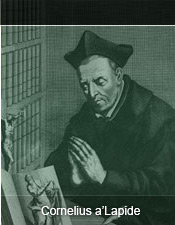- Acknowledgments
- Preface - Chapter I
- Preface - Chapter II
- Preface - Chapter III
This modern English language edition of the Commentary of Cornelius a Lapide has been an ongoing project of Loreto Publications since our inception in 1999. The inspiration for this accomplishment is due primarily to the late Father Leonard Feeney, M.I.C.M., who was trained and ordained by the very same Jesuit order to which Cornelius a Lapide belonged. Much of his theology and deep love of Holy Scripture was due to his familiarity with the complete works of a Lapide in Latin; a love that he has successfully passed on to all of his disciples, but especially to Brother Francis Maluf, M.I.C.M., who has also been my inspiration and my mentor.
We would like to thank the following people who have made invaluable contributions to this project: Charles Coulombe for the wonderful foreword, Saint Benedict Center for the loan of their Latin edition of these Commentaries, Brother Anthony Giambrone O.P. for his excellent work on the Hebrew portions of the text, Sharon Rose Bryan (Bersaw) for her patience and long hours spent on the early layout design and proofing work, Gerry Maicher, Brian Pouliot, and John Parrot of Preserving Christian Publications for their financial assistance and their early work and encouragement of the project, Father Kevin Robinson S.S.P.X. and Michael McDonnell for their encouragement and their scanned text of Mossman’s work, Michael J. Miller for his translation, proofreading and editing, Brian Kelly for his editorial assistance, Loreto’s customers and supporters who have made this work possible, especially those subscribers who have assisted financially toward, and patiently waited for, the completion of this work. A special thanks is also due to Christopher Sarsfield and Jesse Griffiths for their layout and design work in the final stages. Without them this work would not be in your hands right now.
Brother Francis, M.I.C.M., in his book of meditations, Challenge of Faith, notes under the heading of gratitude, that “The state of grace is one of mutual gratitude between God and us. Indeed, God is excessively grateful to those who cooperate with his graces; He also is very much hurt by lack of gratitude—Where are the nine?” (Lk. 17:17). This infinitely precious commentary is in your hands by the grace of God and the work of many hands and minds. Would you also show your gratitude by offering one Ave for all who have contributed in any way? Our mutual gratitude will be pleasing to our Lord, our Lady, and Saint Joseph and thereby will the Mystical Body of Christ be strengthened in the world.
Douglas Bersaw, and all the staff at Loreto Publications
As a final note we wish to mention that there are several terms which occur throughout the a Lapide commentary text which deserve explanation. They are:
Monotessaron or Chronotaxin: These terms refer to a chronological arrangement of Christ’s years and deeds. In the Latin edition it is printed right after the Prooemium in Evangelium, Prologue to the Gospel.
Passim = here and there.
The Imperfect Author is Theodoret (*393 - +458), the author of The Imperfect Commentary, so called because he did not write a commentary on all the books of the Bible.(Possibly also because not all of his commentaries were readily available;his volume on Isaiah was rediscovered only in 1932.)
The Interlinear Gloss (often referred to by a Lapide as simply Gloss) is one part of the Triplex Glossa (Threefold Gloss).This gloss is inserted between the lines of the text of Sacred Scripture. The author is thought to be Anselm of Laon (flourished around 1110), a student of Anselm of Canterbury and an early scholastic systematic theologian.
